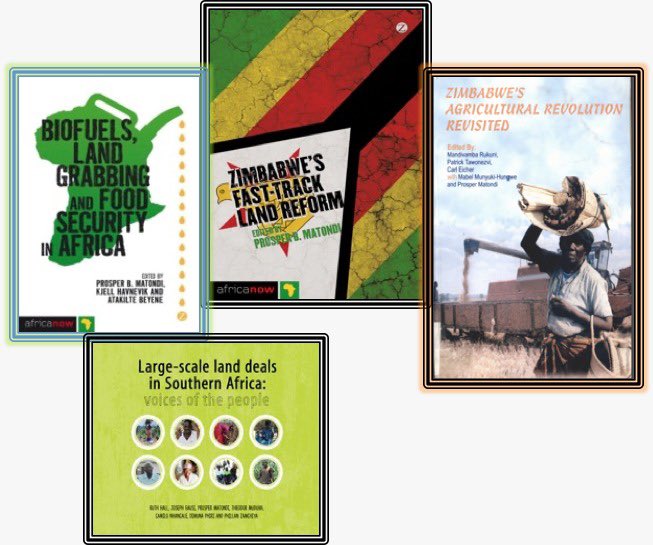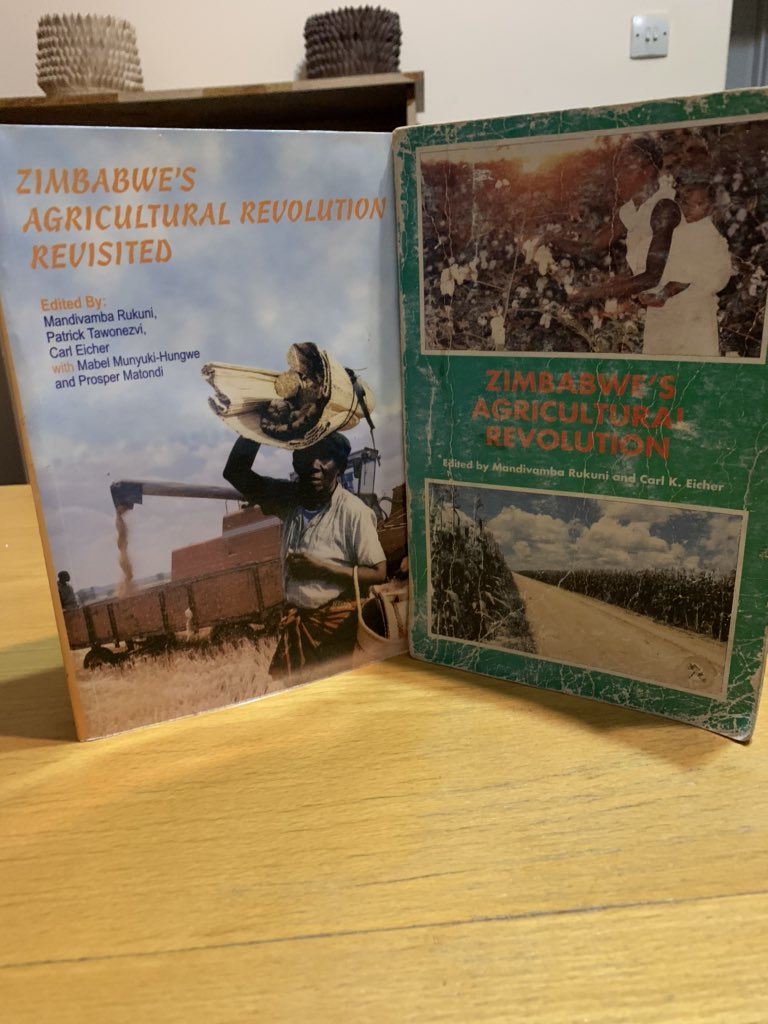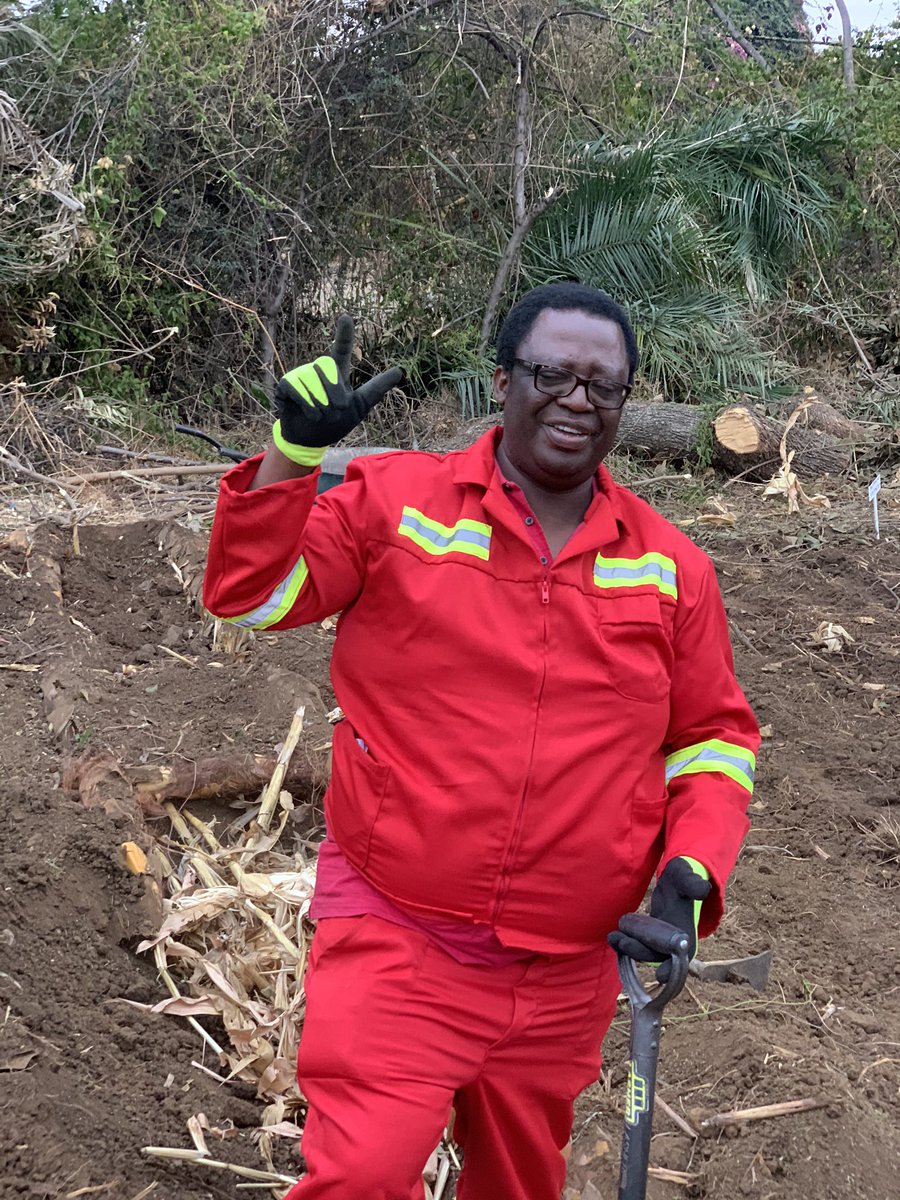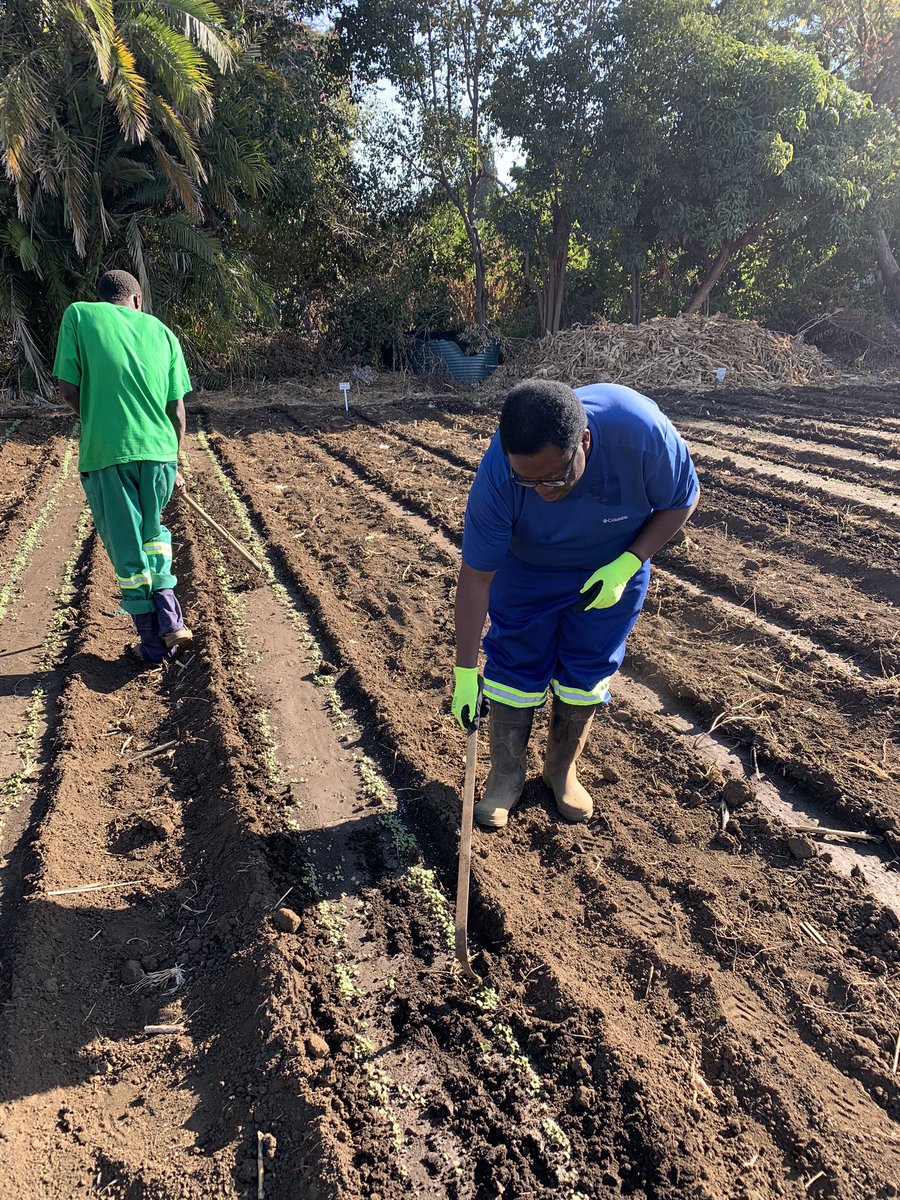Please help me welcome our next curator @bvumie . Prosper Matondi is an expert in rural development and policy analyst on a range of subjects. He specializes in agriculture and related matters. He is the founder and executive director of @RuzivoTrust.
He is a trustee and board member of many organisations that work in water, rural development, while providing special advise on a range of subjects such as food security, renewable energy, climate change and decentralized development.
In this session, he will lead in unpacking the prime movers of regenerative agricultural development with a focus on
1. Agric production
2. Biological capital and growth of agric in context of climate change, 3. Technological development and improvement
1. Agric production
2. Biological capital and growth of agric in context of climate change, 3. Technological development and improvement
4. Institutional reform and favorable policy environment
5. Getting land reform work for agriculture and the economy
6. Human capital formation to sustain gains.
5. Getting land reform work for agriculture and the economy
6. Human capital formation to sustain gains.
Welcome folks! I will be engaging on a range of strategic factors in agriculture centred around the prime movers. These were defined Zimbabwe Agriculture Revolution first published in 1994. We have refined them & a basis for our conversation today with specific examples
I will share with you in parts, the prime movers in agriculture. At the same time I will take this opportunity to engage the agricultural policy making, and subsets of policies that facilitates or hinder the growth of agriculture.
I work in a highly contested policy arena, induced by a variety of factors. Some of these are long-term and shape our history of farming in the context of  https://abs.twimg.com/emoji/v2/... draggable="false" alt="🇿🇼" title="Flagge von Simbabwe" aria-label="Emoji: Flagge von Simbabwe"> . While, technologies can bridge the production gap, there are fundamental limitations that require engagement ...
https://abs.twimg.com/emoji/v2/... draggable="false" alt="🇿🇼" title="Flagge von Simbabwe" aria-label="Emoji: Flagge von Simbabwe"> . While, technologies can bridge the production gap, there are fundamental limitations that require engagement ...
There are equally millions of people who depend on agric for food, jobs, and incomes. The farmer who produce in the field, is the single most important asset in human societies. Agriculture retains strategic importance, as governments prescribe policies to ensure food security.
As I present the agricultural prime movers, I would be happy to take questions, issues, advise etc. I will also share with you a variety of prototypes designed, tested and some being implemented in the context of global and local agricultural transformation.
Agriculture is not just a big business, but equally a basis for survival for millions. In the case of Zimbabwe we are yet to optimize the opportunities that agriculture provides. While climatic factors have been a limitation, it is our inability to innovate that stands in the ..
.... way for progress. The land reform Programme in  https://abs.twimg.com/emoji/v2/... draggable="false" alt="🇿🇼" title="Flagge von Simbabwe" aria-label="Emoji: Flagge von Simbabwe"> is the greatest achievement, but it can only be effective if the land fights of yesteryear are turned and tuned to production. It will place the country into global competitiveness in agriculture. This has been done before..
https://abs.twimg.com/emoji/v2/... draggable="false" alt="🇿🇼" title="Flagge von Simbabwe" aria-label="Emoji: Flagge von Simbabwe"> is the greatest achievement, but it can only be effective if the land fights of yesteryear are turned and tuned to production. It will place the country into global competitiveness in agriculture. This has been done before..
Let me remind of the 5Ms that anchor a better understanding of agriculture: 1. Mouths; 2. Markets; 3. Machinery; 4. Manpower  https://abs.twimg.com/emoji/v2/... draggable="false" alt="🙈" title="Nichts sehen-Affe" aria-label="Emoji: Nichts sehen-Affe"> (Human Capital); 5. Money. These broadly defines key elements of agriculture and any form of value supply systems with inputs & outputs.
https://abs.twimg.com/emoji/v2/... draggable="false" alt="🙈" title="Nichts sehen-Affe" aria-label="Emoji: Nichts sehen-Affe"> (Human Capital); 5. Money. These broadly defines key elements of agriculture and any form of value supply systems with inputs & outputs.
Prime 1. Is about production and there are MOTIVATORS (a set of facts) that makes agriculture everyone’s business. Yet, we must deal DEMOTIVATORS. Let me take each one for clarity.
Motivators - in  https://abs.twimg.com/emoji/v2/... draggable="false" alt="🇿🇼" title="Flagge von Simbabwe" aria-label="Emoji: Flagge von Simbabwe"> like many developing countries land provides the greatest opportunity, only if it is accessible to those who want to farm. With just above 12 millions hectares of already developed commercial agricultural we have the greatest asset that needs to be put to use
https://abs.twimg.com/emoji/v2/... draggable="false" alt="🇿🇼" title="Flagge von Simbabwe" aria-label="Emoji: Flagge von Simbabwe"> like many developing countries land provides the greatest opportunity, only if it is accessible to those who want to farm. With just above 12 millions hectares of already developed commercial agricultural we have the greatest asset that needs to be put to use
This is in addition to 16.4 million hectares in the customary system that has at least 1.2 million family farmers. In the context of #Pfumvudza @MoLAWRR_Zim this climate proof Programme can transform family farmers in the context of climate change. ....
Yet more importantly #PLATE (Phyto-sanitary Livestock Active Traceability Enterprise) can place livestock production that addresses livestock productivity for structural change with strong headway by the private sector and supporting institutional players ....
A key point I am labouring is that we have lost time, resources, skills for massification of production. Strategies are needed now than ever before. Small projects alone, will not address the dire food situation in the context of climate & now Covid19 that has disrupted supplies
A summary of demotivators that conspire against agriculture  https://abs.twimg.com/emoji/v2/... draggable="false" alt="👉🏿" title="Rückhand Zeigefinger nach rechts (dunkler Hautton)" aria-label="Emoji: Rückhand Zeigefinger nach rechts (dunkler Hautton)"> low productivity; at commercial levels there is poor farming skills; high production costs; limited suitable finance schemes; shortage of locally produced raw materials, dependency on the use of the hoe (badza)
https://abs.twimg.com/emoji/v2/... draggable="false" alt="👉🏿" title="Rückhand Zeigefinger nach rechts (dunkler Hautton)" aria-label="Emoji: Rückhand Zeigefinger nach rechts (dunkler Hautton)"> low productivity; at commercial levels there is poor farming skills; high production costs; limited suitable finance schemes; shortage of locally produced raw materials, dependency on the use of the hoe (badza)  https://abs.twimg.com/emoji/v2/... draggable="false" alt="😏" title="Grinsendes Gesicht" aria-label="Emoji: Grinsendes Gesicht">...
https://abs.twimg.com/emoji/v2/... draggable="false" alt="😏" title="Grinsendes Gesicht" aria-label="Emoji: Grinsendes Gesicht">...
.... poor adoption of drought tolerant varieties; generally poor livestock breeding despite spirited attempts to speed AI; depletion of indigenous forests due to overuse in tobacco curing; near death of agroforestry that is vital for climate change mitigation...
... little value addition, poorly developed infrastructure and distribution systems (we need reform and improvement of national rail to move products), contested contract farming schemes; ...
Inadequate farmer representation, as values for representation has been lost over the years; inadequate matching of farmer needs and extension systems contributing to haphazard production not matched to demand.
Limited research and development, with over ambitious proposal on systems like hudroponics or agroponics that are well and good to have. Yet, we got so much land and underutilized water resources for us to do basic farming that considers the small to medium agrarian structure.
I have always challenged colleagues in agriculture and rural development. I ask, how do we end extreme poverty with a rural face. I have no doubt that Agriculture is central, including the ecosystems that provides a vantage. This takes me to the next enabler, if i May call it https://abs.twimg.com/emoji/v2/... draggable="false" alt="😊" title="Lächelndes Gesicht mit lächelnden Augen" aria-label="Emoji: Lächelndes Gesicht mit lächelnden Augen">
https://abs.twimg.com/emoji/v2/... draggable="false" alt="😊" title="Lächelndes Gesicht mit lächelnden Augen" aria-label="Emoji: Lächelndes Gesicht mit lächelnden Augen">
Prime mover 2: that is sustained growth in biological capital, including key enablers that is water, renewable energy costs, financial services, ICTs that needs deployment at farm level on a sustained basis.
In mastering biological resources, agriculture recovery is #Pfumvudza. Well some recall it as conservation agriculture “diga ufe” (dig and die), but far from it, this is a key tested innovation for increasing yields, ensure food security & nutrition at hhd level ..
#Pfumvudza as renewal or a new season, reflects intense organisation of resources through climate proofing support to small family farmers who are the majority in rural Zimbabwe. It is a statement of intent, and needs a holistic view. So far prototypes shows good results
Let me take you to the framing! Zimbabwe is divided in 5 agro-ecological regions. This was done in the 1960s. This was the basis for success of the 1st agricultural revolution. The demarcation of regions was such that production was tailored to the endowment of each region ...
This framing is 60 years old, and so many changes have taken place. Least being the rapid climate change phenomenon that has significantly affected agriculture principally. We need serious well funded research to understand the climate shifts to put a better planning framework
If you are interested to invest in agriculture value supply system, you need to know the physical context better - rainfall, soils, vegetation, as primary. Next is human developed infrastructure - communications, energy (& replacement renewable energy), water harvest & storage
Nurturing plants and at low infrastructure costs to deploy systems in taking advantage of the natural endowment is key to farming. I am in my small garden that I have transformed in the last 2 months. Soil fertility and improvement is key.
Understanding new markets constructed by new groups of actors (e.g. women, youths) shows the robustness of their experiences in constructing markets that fit their interests & enhance livelihoods. These markets are resilient, as shown by capacity to supply in face of adversity
When markets are analyzed based on specific commodity, there seems to be poor http://organisation.My"> http://organisation.My usual example is when egg producers from Chegutu town come to Mbare, to then hv the same eggs transported past Chegutu to Byo or Vic Falls.I still want to understand the logic
Prime mover 4: technology & agric research and adaptation to local conditions. I am a fervent campaigner against the use of the hoe by women as backbone of agric in Africa. We @MushunjeMildred have repeatedly said it must go to the museum & new appropriate & affordable tech ..
ICTs have radically changed how we work, and of immediacy has been Covid19 with a raft of emergency measures to stop the spread of the pandemic. Yet people must eat the farmers produce. Despite the disruptions, the food supply systems is an essential service sector ...
With a combination of traditional walk into fresh produce shops @smallholder_zw have grown and moved tones of fresh produce in 6 towns. New methods of reaching consumers and markets are being explored and emerging as business methods of the future
... a key matter is what such market linkages mean for vegetable producers of all types and sizes. Three aspects: farm to urban, intercity and export markets. The distribution system is being transformed and needs for better commodity production & supply planning ....
On the other hand, the livestock value chain that was merciless under attack by Theolisis, and ravages of drought in the current farming season has meant disruption in supply of meat products to the main markets. I completed a few months ago, a study of the Vic Falls Food system
A key finding was that much of the beef, chicken and egg supply including goat meat was locally procured. Yet demand was growing had its not been for Covid19. No doubt that markets will be reopened, the question is how the supply system will work and will trigger reformed ...
... markets in view of internalization of produce as a priority above exports worldwide. This is the time to plan and invest in credit markets, public and private extension to push not only yields but the scale of production to meet demand
Policy subsets: the National agric policy frame has concise pillars.
In order to operationalise the sector, it needs an implementation plan, a communication strategy, a peer review of progress on an annual basis, and linkages to a variety of related policies and legal frameworks
In order to operationalise the sector, it needs an implementation plan, a communication strategy, a peer review of progress on an annual basis, and linkages to a variety of related policies and legal frameworks
.... good intentions may be impeded from other sectors. Therefore communication and policy trade offs must be encouraged in the context of Zimbabwe. Just as an example, monetary/fiscal policies, import regulations, local licensing may have disincentives to agriculture
... these negotiable matters must be encouraged and placed in the agric policy implementation plan. A key dimension of inclusiveness and a need to devolve agri policy to the provinces and districts for their exercise and adaptation to local conditions to boost production ...
I am very hesitant on the continuous use of the Afro-ecological regions, without a review. There for in the meantime, administrative units could be helpful for policy to effective and reach farmers as they make decisions of their production ...
.... to further actualise the policy subsets that is : food & nutrition security, irrigation dev, livestock & fisheries, technology &mechanization and related prirorities.
A policy modifier, must be included as an intervention tool when agriculture is under seizure (diseases...
A policy modifier, must be included as an intervention tool when agriculture is under seizure (diseases...
... pests, pandemics, cyclones, droughts, floods) beyond human control. The financing aspects are key to know the strategy for resource mobilization within and outside the domain of gvt. Encouraging and incentivizing private sector to be competitive is a key policy strategy
Prime mover 6: it has been such a day. Let me re-energize for this one  https://abs.twimg.com/emoji/v2/... draggable="false" alt="👇🏾" title="Rückhand Zeigefinger nach unten (durchschnittlich dunkler Hautton)" aria-label="Emoji: Rückhand Zeigefinger nach unten (durchschnittlich dunkler Hautton)">. One of my outstanding books, with a firm grip of knowledge on land reform &its understanding.Yes, agric policy can’t move exclusively without addressing the elephant in the room.
https://abs.twimg.com/emoji/v2/... draggable="false" alt="👇🏾" title="Rückhand Zeigefinger nach unten (durchschnittlich dunkler Hautton)" aria-label="Emoji: Rückhand Zeigefinger nach unten (durchschnittlich dunkler Hautton)">. One of my outstanding books, with a firm grip of knowledge on land reform &its understanding.Yes, agric policy can’t move exclusively without addressing the elephant in the room.
Let’s catch up in a while
Let’s catch up in a while
Land land land .... I will not dwell on the history of it, but to emphasize that Zimbabwe’s land reform was perhaps the most radical solution to inequalities on land based on race. That history will perhaps remain as a key signature on Zimbabwe’s & its international relations ..
A necessary pain that needs new headway into re-imagining the agric sector into the future. There are victors and victims, and policy and strategies are needed to cogently address comprehensively the matters that are still contested, but are moot in the current juncture ...
The key outstanding matters are: review of land tenure & rights for holders; addressing compensation matters &completion of land valuation to inform the process; govt to assist the Zimbabwe Land Commission (ZLC) to enhance dispute resolution mechanisms wth relevant legal clarity
... strengthen land governance and administration including systems of land allocation; review land use planning and reverting to tried systems of land use assessments on commercial land; enhance land surveys, registrar and cadastre when it is necessary ....
.... Reframing and enacting land conservation to protect the national heritage. This needs precise inclusion of such land protection measures in the 99 year lease and permits for acquired land ....
The intensity of the land reform Programme has had deliterious effects on other tenure regimes that is communal areas; old resettlement areas (1980-1997); small scale commercial farms (designed in 1931) with signs of exhaustion and needing a trigger to make them productive ...
State lands (parks, urban and peri-urban, ARDA farms and other state land leased to individuals and colorations). I am still persuaded that we require a land policy that speaks to the challenges. Only if such a policy helps agriculture recovery & food security
Among clarity is land tenure policy that reviews forests and plantations, private wildlife zones (conservancies), developed land for irrigation, including sensitive ecological areas as already mapped by the Environemt Management Agency (EMA).
I have argued elsewhere that land is not an infinite resources. The allocations & beneficiation is not charity but giving responsibility to such to produce and meet the food security and agric raw materials for the manufacturing and services sector ....
Flaunting land that is not used, is injustice to those who cannot access land and suffer food insecurity. All commercial land must be used. The A1 , A2, Old Resettlement and SSCF are not retirement homes but agric production factories for the nation. To address land matters ...
.... requires clarity of rights: occupancy, usufract, transferability, exclusion/inclusion, temporary leases and licensing, adjudication & access to justice for any land holder. All these elements require a common criteria that can be easily be established through a land policy
Strengthening the administrative institutions is a priority to reduce red tape, overlapping mandates, with a clear understanding of delivering land resources across social, economic and political spectrums. Access to land and land rights must be fair and equitable being ...
Gender sensitive and directly benefit women, youths interested in farming or in transition, ensuring rights of minorities and the disabled. Delivering land needs a clear national framework that aligns with agric policy objectives.
Let me wind up by saying, the not yet stated in the national social contract and covenant that the constitution. I strongly believe that every born Zimbabwean must be accorded access to residential land at 18 years. This offset, competition for agricultural land ....
.... where some are seeking land for residential and retirement. Mechanisms of how that will work, will depressurize demand for land as an asset that may not be used....
Investing in land data is crucial for decisions to be made at national and the devolved levels. If that is done, then the 3rd agricultural revolution of Zimbabwe will be on course.
I hope to be invited to curate on access to land and tenure. My interest and work on climate change, renewable energy, social protection, nutrition.
It has been a pleasure spending a day with you and back to my little garden! Yes, the 6 prime movers must move us to a better food secure nation. Wealth will come from land, and let’s make it work for all of us. Good evening  https://abs.twimg.com/emoji/v2/... draggable="false" alt="🙏🏼" title="Folded hands (mittelheller Hautton)" aria-label="Emoji: Folded hands (mittelheller Hautton)">
https://abs.twimg.com/emoji/v2/... draggable="false" alt="🙏🏼" title="Folded hands (mittelheller Hautton)" aria-label="Emoji: Folded hands (mittelheller Hautton)">

 Read on Twitter
Read on Twitter


 . One of my outstanding books, with a firm grip of knowledge on land reform &its understanding.Yes, agric policy can’t move exclusively without addressing the elephant in the room.Let’s catch up in a while" title="Prime mover 6: it has been such a day. Let me re-energize for this one https://abs.twimg.com/emoji/v2/... draggable="false" alt="👇🏾" title="Rückhand Zeigefinger nach unten (durchschnittlich dunkler Hautton)" aria-label="Emoji: Rückhand Zeigefinger nach unten (durchschnittlich dunkler Hautton)">. One of my outstanding books, with a firm grip of knowledge on land reform &its understanding.Yes, agric policy can’t move exclusively without addressing the elephant in the room.Let’s catch up in a while" class="img-responsive" style="max-width:100%;"/>
. One of my outstanding books, with a firm grip of knowledge on land reform &its understanding.Yes, agric policy can’t move exclusively without addressing the elephant in the room.Let’s catch up in a while" title="Prime mover 6: it has been such a day. Let me re-energize for this one https://abs.twimg.com/emoji/v2/... draggable="false" alt="👇🏾" title="Rückhand Zeigefinger nach unten (durchschnittlich dunkler Hautton)" aria-label="Emoji: Rückhand Zeigefinger nach unten (durchschnittlich dunkler Hautton)">. One of my outstanding books, with a firm grip of knowledge on land reform &its understanding.Yes, agric policy can’t move exclusively without addressing the elephant in the room.Let’s catch up in a while" class="img-responsive" style="max-width:100%;"/>
 " title="It has been a pleasure spending a day with you and back to my little garden! Yes, the 6 prime movers must move us to a better food secure nation. Wealth will come from land, and let’s make it work for all of us. Good evening https://abs.twimg.com/emoji/v2/... draggable="false" alt="🙏🏼" title="Folded hands (mittelheller Hautton)" aria-label="Emoji: Folded hands (mittelheller Hautton)">">
" title="It has been a pleasure spending a day with you and back to my little garden! Yes, the 6 prime movers must move us to a better food secure nation. Wealth will come from land, and let’s make it work for all of us. Good evening https://abs.twimg.com/emoji/v2/... draggable="false" alt="🙏🏼" title="Folded hands (mittelheller Hautton)" aria-label="Emoji: Folded hands (mittelheller Hautton)">">
 " title="It has been a pleasure spending a day with you and back to my little garden! Yes, the 6 prime movers must move us to a better food secure nation. Wealth will come from land, and let’s make it work for all of us. Good evening https://abs.twimg.com/emoji/v2/... draggable="false" alt="🙏🏼" title="Folded hands (mittelheller Hautton)" aria-label="Emoji: Folded hands (mittelheller Hautton)">">
" title="It has been a pleasure spending a day with you and back to my little garden! Yes, the 6 prime movers must move us to a better food secure nation. Wealth will come from land, and let’s make it work for all of us. Good evening https://abs.twimg.com/emoji/v2/... draggable="false" alt="🙏🏼" title="Folded hands (mittelheller Hautton)" aria-label="Emoji: Folded hands (mittelheller Hautton)">">
 " title="It has been a pleasure spending a day with you and back to my little garden! Yes, the 6 prime movers must move us to a better food secure nation. Wealth will come from land, and let’s make it work for all of us. Good evening https://abs.twimg.com/emoji/v2/... draggable="false" alt="🙏🏼" title="Folded hands (mittelheller Hautton)" aria-label="Emoji: Folded hands (mittelheller Hautton)">">
" title="It has been a pleasure spending a day with you and back to my little garden! Yes, the 6 prime movers must move us to a better food secure nation. Wealth will come from land, and let’s make it work for all of us. Good evening https://abs.twimg.com/emoji/v2/... draggable="false" alt="🙏🏼" title="Folded hands (mittelheller Hautton)" aria-label="Emoji: Folded hands (mittelheller Hautton)">">
 " title="It has been a pleasure spending a day with you and back to my little garden! Yes, the 6 prime movers must move us to a better food secure nation. Wealth will come from land, and let’s make it work for all of us. Good evening https://abs.twimg.com/emoji/v2/... draggable="false" alt="🙏🏼" title="Folded hands (mittelheller Hautton)" aria-label="Emoji: Folded hands (mittelheller Hautton)">">
" title="It has been a pleasure spending a day with you and back to my little garden! Yes, the 6 prime movers must move us to a better food secure nation. Wealth will come from land, and let’s make it work for all of us. Good evening https://abs.twimg.com/emoji/v2/... draggable="false" alt="🙏🏼" title="Folded hands (mittelheller Hautton)" aria-label="Emoji: Folded hands (mittelheller Hautton)">">


